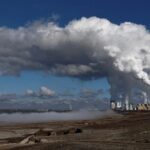By Jack Phillips
A major New England grid operator said it is preparing for a possible strain on the grid amid a surge in demand for natural gas that threatens to reduce supplies.
ISO New England Inc., the power grid operator in the northeastern United States, warned that an especially cold winter could spark blackouts due to not enough natural gas that’s designed for power generation, officials told the Wall Street Journal on Monday.
“The most challenging aspect of this winter is what’s happening around the world and the extreme volatility in the markets,” Vamsi Chadalavada, the chief operating officer for ISO New England, told the paper in an interview.
LS Power Development LLC Vice President Nathan Hanson said his firm is filling backup tanks with oil to produce in case the natural gas supply dries up.
“The grid overall is in a much tighter position,” he told the outlet. “If we get a sustained cold period in New England this winter, we’ll be in a very similar position as California was this summer.”
But Thad Hill, the chief executive of Calpine Corp.—an operator of plants in the northeastern region—said that fuel supplies for the winter will be expensive. But he does not anticipate any power outages or strain on the grid.
“The goal should be to put in place a market mechanism that’s actually durable for all but the most egregious situations,” he told the WSJ.
Meanwhile, the U.S. Energy Information Association’s short-term energy outlook that was posted last week shows that wholesale prices at trading hubs will be 20 to 60 percent higher on average for winter 2022–23.
“The highest wholesale electricity prices are likely to be in New England because of possible natural gas pipeline constraints, reduced fuel inventories for power generation, and uncertainty regarding liquefied natural gas (LNG) shipments given the tight global supply conditions,” the agency said.
No Curbs on Exports
Earlier this month, unnamed White House officials told Reuters that there will be no ban or curbs on natural gas exports this winter. The officials say they want to help alleviate energy shortages in Europe following the Russia–Ukraine conflict and bans on Russian energy in recent months.
Biden administration officials are bracing for the prospect that inflation-fatigued Americans will pay high home-heating bills this winter. Inventories of natural gas, the nation’s primary heating fuel, are at historically low levels after U.S. companies exported record amounts to Europe in recent months to counter a cut in supplies and higher prices for European power plants.
“And because of the steps we and our partners have been taking, gas storage in Europe is at a significantly higher level than last year. More work remains,” one official said.
The average cost of U.S. home heating is expected to rise 17.2 percent from last winter to $1,202, putting millions of low-income families at risk of falling behind on their energy bills, according to a recent report by the National Energy Assistance Directors’ Association (NEAD).
Cold Air
This week, temperatures in the Midwest and East Coast are slated to plummet as a mass of Arctic air is forecast to descend on areas east of the Rocky Mountains.
“Much below normal temperatures with morning frost/freeze conditions are expected for much of the eastern U.S. behind a strong cold front for the first half of the week,” said the National Weather Service in a Monday morning update.
“The Northwest will remain warmer than normal over the next few days thanks to the continued presence of upper-level high pressure resulting in some record temperatures and areas of wildfire smoke with unhealthy air quality.”
Reuters contributed to this report.






